A guest post by Georgina E. M. Wilson
In act 1 scene 2 of Shakespeare’s The Two Gentlemen of Verona, Antonio discusses his son with his friend Panthino. Panthino advises Antonio to let his son ‘spend his time no more at home’, and Antonio agrees:
I have consider’d well his loss of time
And how he cannot be a perfect man,
Not being tried and tutored in the world (1.2.19–21).
His son, Proteus, needs to travel out of his home environment in order to perfect himself as a man. To deny geographical mobility to a young man is also to cause him a ‘loss of time’: a temporal impediment to his intellectual development.
Texts, like people, move through time and space, altering as they do so. The Two Gentlemen of Verona comes down to us through four hundred years of printing and production history. If the ‘home’ of this play is the Elizabethan London in which it was written, it is also the Italian Renaissance in which the play is set. But it is additionally the places and moments in which the play has been read and performed since its conception. The RSC website records twelve productions in Stratford since 1879, each of which sets the play in a particular moment and provides its own interpretative spin. Meanwhile editions of the play range from the 1623 first folio to Mary Cowden Clark’s Shakespeare’s Works: Edited With a Scrupulous Revision of the Text (1860)[1], to the fourth Arden series edited by Tiffany Stern, Peter Holland and Zachary Lesser currently underway. The Two Gentlemen of Verona has undergone the kind of treatment recommended for Proteus: has already been, if not ‘perfected by the swift course of time’, then at least subjected to the cultural forces of centuries and places beyond its own.
Recently I came across a copy of The Two Gentlemen of Verona which shed new light on these lines by showing quite how far a book could travel from its home context. I met with Jane and John Jeffery, decorative paper-makers or ‘buntpapierists’ based in Edinburgh, who use loose sheets and printers waste from the sixteenth to the twentieth centuries as a substrate for decorative printing.[2] The patterns that the Jefferys deploy on top of the texts are themselves taken from printer’s lace from other sheets in their collection, leading to a cycle of visual reuse and reproduction. Their collection includes loose sheets from the 1901 ‘Edinburgh folio’ of Shakespeare’s complete works, published by Grant Richards. Page 89 from volume one, which runs from ‘Ay Madam’ (The Two Gentlemen of Verona 1.2.138) to ‘converse with noblemen’ (1.3.31), is just one of the sheets which has been transformed into decorative paper. I had to check those lines against my own Arden Complete Works (edited by Richard Proudfoot, Ann Thompson and David Scott Kastan) because they have been partly hidden by the yellow, pink and blue flowers and insects that hover above the text. This is a fragment of Two Gentlemen of Verona which has been transformed into something new. Divisions of scenes, acts, and sentences are overruled by the unit of the page, which is no longer only an extract from a codex but the frame of a visually articulated space.
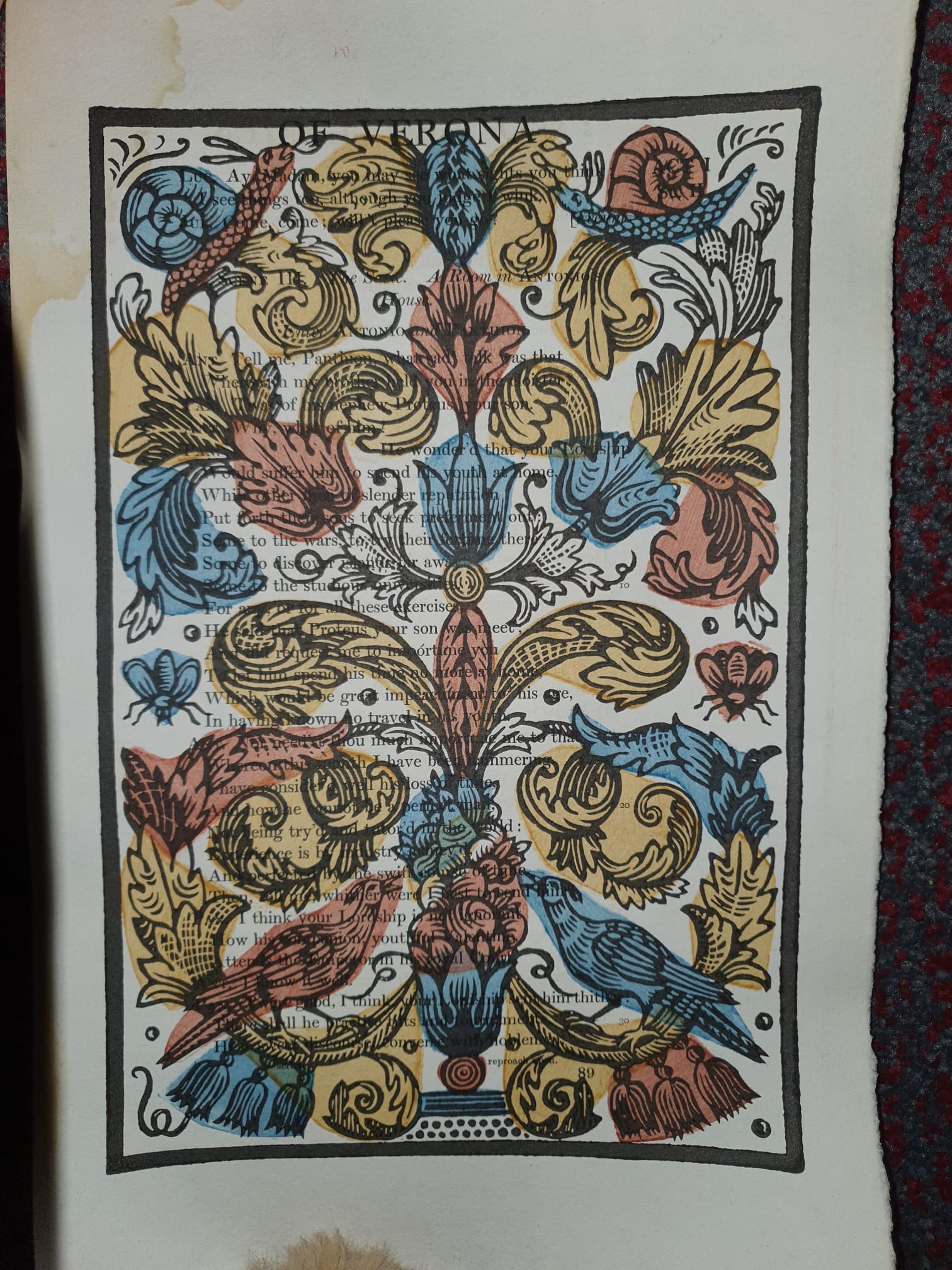
Another book whose pages the Jefferys have printed on is the sixth edition of Samuel Johnson’s Dictionary, printed in 1785. The pages aren’t numbered, but the one which runs from ‘angel’ to ‘angry’ can be identified as sig. L4r using the digital edition on Eighteenth Century Collections Online. About half of the text on this page is covered by the picture of two men standing by a body of water traversed by two boats, which divides them from a city in the background. The image erases many words and draws our attention to those which remain legible: ‘plainly deducible’ springs from the top of the central column, while ‘A’NGLE’ is reduced to NGL (Not Gunna Lie?!) The alphabetic logic of dictionaries like Johnson’s brings together seemingly semantically incongruous words, and in doing so suggests connection between them. Printing over a dictionary page while leaving only some of the words legible creates new narratives out of what is already there. We might now read this page as a text about Milton’s Paradise Lost, from which Johnson quotes the line ‘fair angelick Eve’ (now buried under ink), and whose epic narrative opens with the war between the angel Lucifer and the ‘angry Victor’.
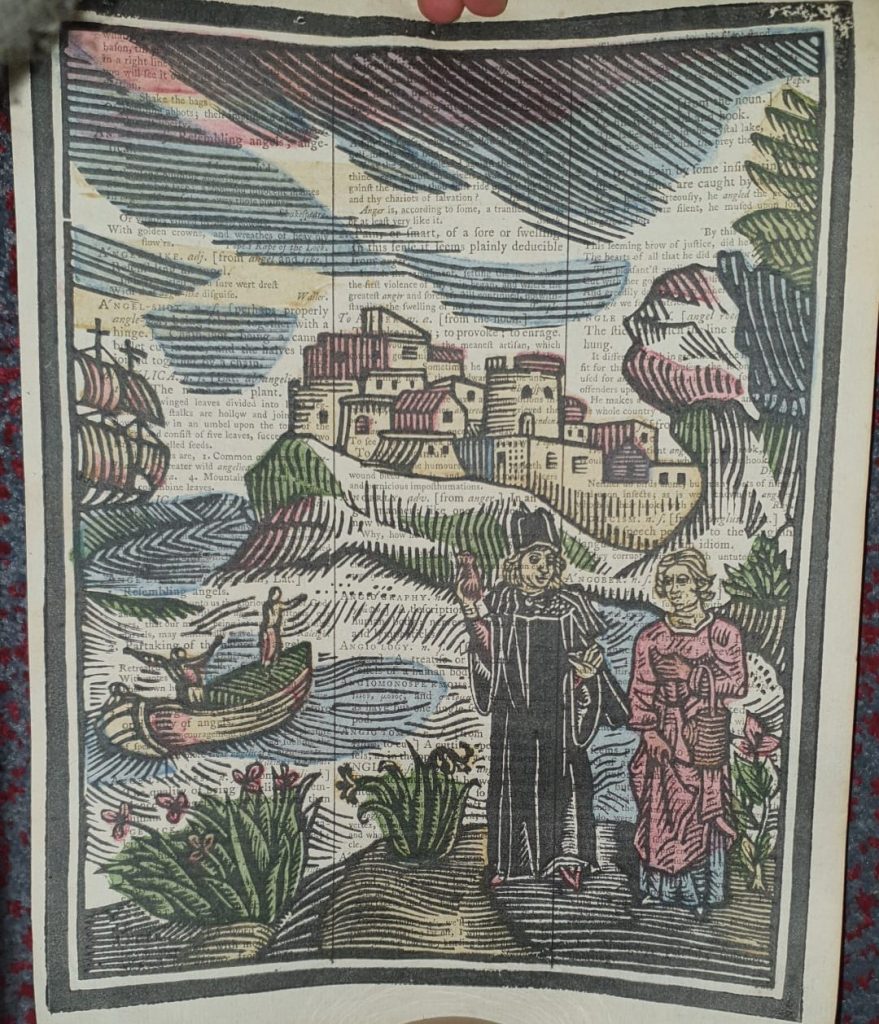
The treated pages of Johnson’s dictionary make other connections between the text in question and the illustration layered on top. Sig. 5G4r, which runs from ‘To Fly in the face’, to ‘Focae’, has been almost entirely printed over by an image of a street, with houses running down either side and a pool of water in the foreground. This scene has been taken from the background to the illustrated capital ‘P’ from sig. A1r of Charles Du Fresne’s Glossarium mediae et infimae Latinitatis (Glossary of writers in medieval and late Latin), initially published in Paris, 1678, and then reprinted in the 1730s. It is this later edition which provided the image printed on top of the page in Johnson’s dictionary, except that the P has been done away with and the engraving blown up to fill an entire page. Knowing where this image came from catapults a French historian onto a page otherwise heavily populated by an Anglo-Irish canon of Shakespeare, Pope, Dryden, and Swift, and weaves a thread between Du Fresne’s Glossarium and Jonson’s Dictionary. Both books share a certain agenda, which is to construct textual histories (whether of writers or of etymologies) that come with their own political, historical, and cultural value systems.
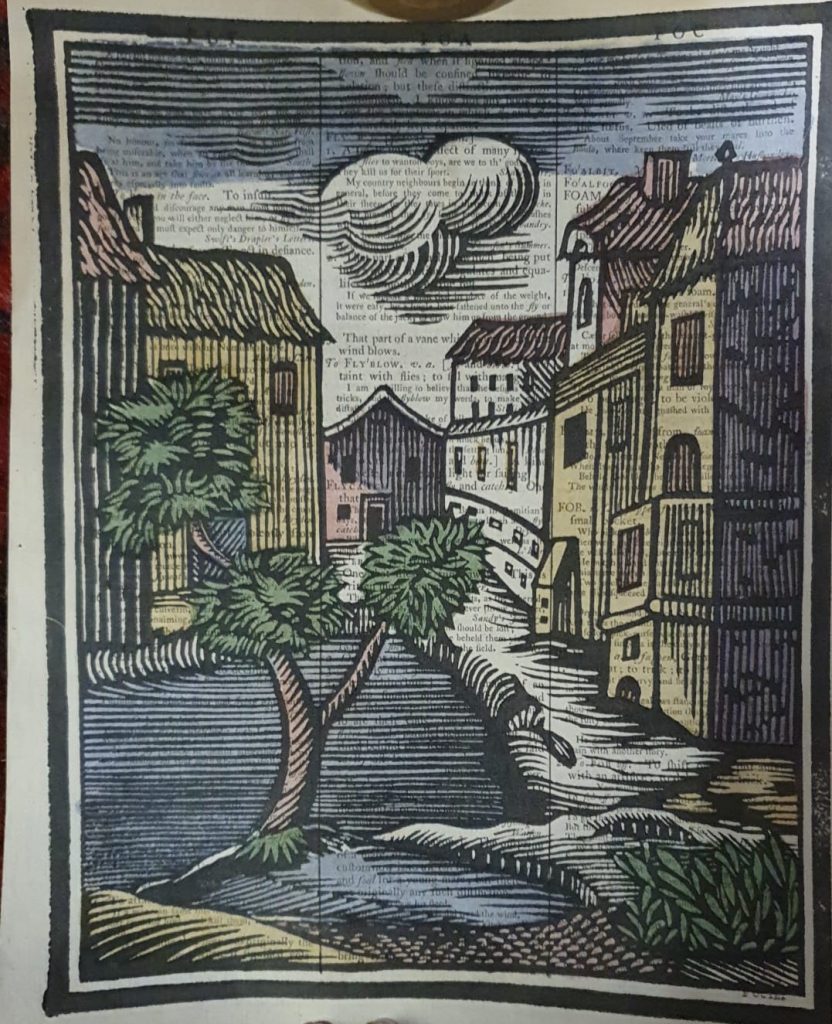
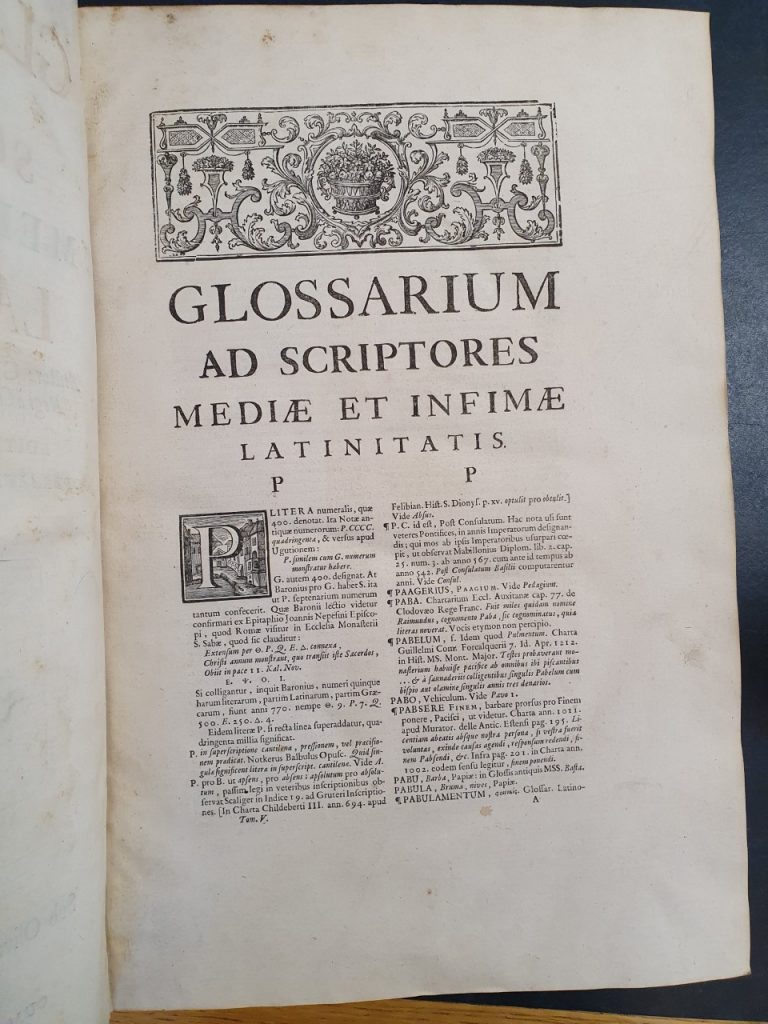
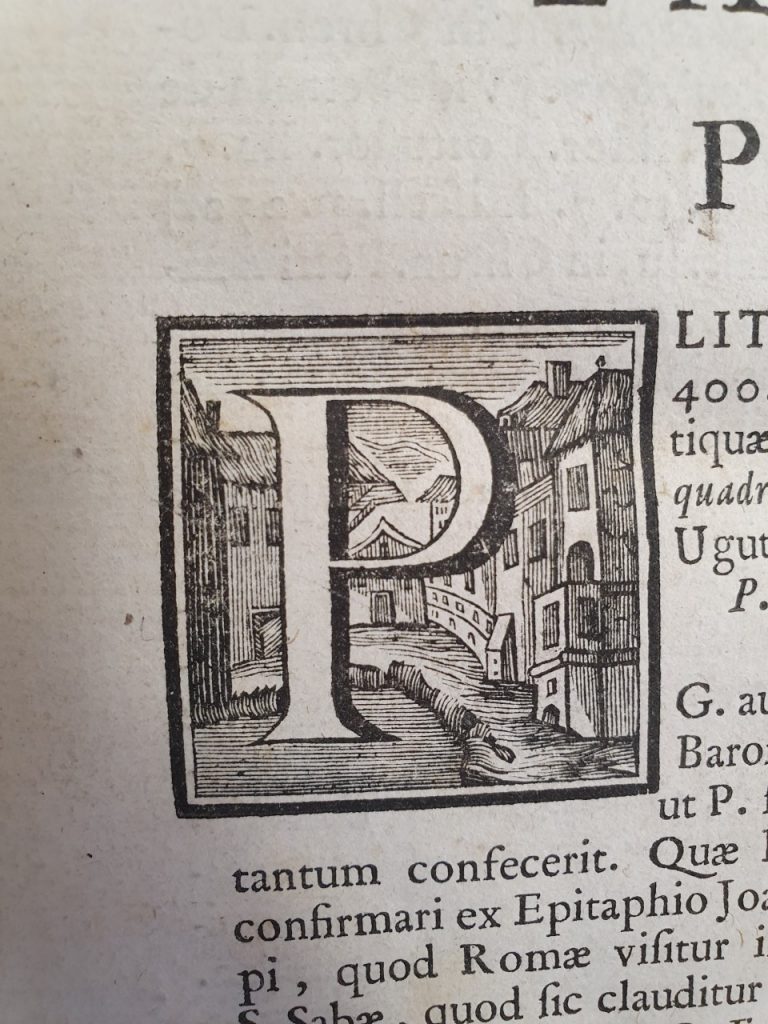
There is a history of treating pages of books to create new texts. The recently deceased Tom Philips (1937–2022) endlessly reworked W. H. Mallock’s conservative novel The Human Document (1892) to make a new satirical narrative.[3] That narrative was itself illustrated by the images with which Philips covered much of Mallock’s prose, leaving only fragments to tell another story. The work of the Jefferys was, they tell me, propelled less by the text and more by the affordances of the paper to support their visual designs. Nevertheless the paper’s original role – as a substrate for an eighteenth-century dictionary and for an early twentieth-century edition of Two Gentlemen of Verona – refuses to fully subside. Text and image play off one another into receding horizons of intertextuality, generated through bibliographic and linguistic quotation. What we have here is a fragment from Jonson’s dictionary from 1785, itself a reprint from 1755, which has been printed over with an image taken from the second edition of De Fresne’s Glossarium, which predates the dictionary by over seventy years. Early modern texts which survive today are inevitably ‘tried and tested by the world’. While this is less the teleological march towards perfection which Antonio desires for his son, it is instead a messily generative story of intertextuality, told through palimpsest, erasure, and juxtaposition.
[1] For a history of women editing Shakespeare see Molly Yarn, Shakespeare’s ‘Lady Editors’: A New History of the Shakespearean Text (Cambridge: Cambridge University Press, 2022).
[2] For the early modern history of recycling printed paper as decorative paper, see Juliet Fleming, ‘Damask Papers’, The Elizabethan Top Ten: Defining Print Popularity in Early Modern England, eds. Andy Kesson and Emma Smith (Ashgate: Surrey, 2013), 179-191.
[3] https://www.tomphillips.co.uk/humument/essays/item/5857-double-act-by-adam-smyth